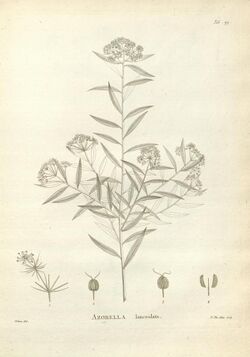Biology:Platysace lanceolata
| Shrubby platyscace | |
|---|---|

| |
| Scientific classification | |
| Kingdom: | Plantae |
| Clade: | Tracheophytes |
| Clade: | Angiosperms |
| Clade: | Eudicots |
| Clade: | Asterids |
| Order: | Apiales |
| Family: | Apiaceae |
| Genus: | Platysace |
| Species: | P. lanceolata
|
| Binomial name | |
| Platysace lanceolata (Labill.) Druce[1]
| |
| Synonyms[1] | |
|
List
| |

Platysace lanceolata, commonly known as shrubby platysace,[3] is a flowering plant in the family Apiaceae and is endemic to south-eastern Australia. It is small, upright shrub with variable shaped leaves and white flowers.
Description
Platyscace lanceolata is an upright or widely spreading shrub to 1.5 m (4 ft 11 in) with stems usually covered in short, soft hairs. The leaves are a dull green, narrow to broadly elliptic, occasionally more or less circular, arranged alternately, 10–50 mm (0.39–1.97 in) long and 4–15 mm (0.16–0.59 in) wide, smooth margins, base heart-shaped, and the apex pointed or rounded. The inflorescence has cream-white flowers in an umbel 15–50 mm (0.59–1.97 in) in diameter, bracts elliptic or linear in shape, 2–7 mm (0.079–0.276 in) long, and on a peduncle 5–30 mm (0.20–1.18 in) long. Flowering occurs from September to March and the fruit 1.5–2 mm (0.059–0.079 in) long, 1.5–2.1 mm (0.059–0.083 in) wide and warty.[3][4][5]
Taxonomy and naming
The species was first formally described by French naturalist Jacques Labillardière in 1805 in the first volume of Novae Hollandiae Plantarum Specimen and given the name Azorella lanceolata.[2][6] The species was transferred to the genus Platysace in 1917 by English botanist George Claridge Druce and the description was published in The Botanical Exchange Club and Society of the British Isles Report for 1916, Suppl.2[6][7]
Distribution and habitat
This platysace is a common, widespread species found growing in heath, scrub, open forests, and sometimes sandy situations in New South Wales, Victoria and Queensland.[3][5]
References
- ↑ 1.0 1.1 "Platysace lanceolata". Australian Plant Census. https://biodiversity.org.au/nsl/services/apc-format/display/81123.
- ↑ 2.0 2.1 Labillardière, Jacques (1805). Novae Hollandiae Plantarum Specimen. Paris. https://www.biodiversitylibrary.org/page/40848310#page/210/mode/1up. Retrieved 5 September 2021.
- ↑ 3.0 3.1 3.2 Powell, J.M.; Hastings, S.M.. "Platysace lanceolata". Royal Botanic Gardens Sydney. https://plantnet.rbgsyd.nsw.gov.au/cgi-bin/NSWfl.pl?page=nswfl&lvl=sp&name=Platysace~lanceolata.
- ↑ Wild Plants of Victoria (database). Viridans Biological Databases & Department of Sustainability and Environment. 2009.
- ↑ 5.0 5.1 Robinson, Les (2003). Field Guide to the native plants of Sydney (3 ed.). Sydney: Kangaroo Press. p. 127. ISBN 0731812115.
- ↑ 6.0 6.1 "Platysace lanceolata". Australian Plant Name Index (APNI), IBIS database. Centre for Plant Biodiversity Research, Australian Government. https://biodiversity.org.au/nsl/services/rest/name/apni/81123.
- ↑ Druce, George (1916). "Platysace lanceolata". The Botanical Exchange Club and Society of the British Isles Report for 1916, Suppl. 2 2: 647. https://www.biodiversitylibrary.org/item/195177#page/719/mode/1up. Retrieved 5 September 2021.
External links
Wikidata ☰ Q7202823 entry
 |

